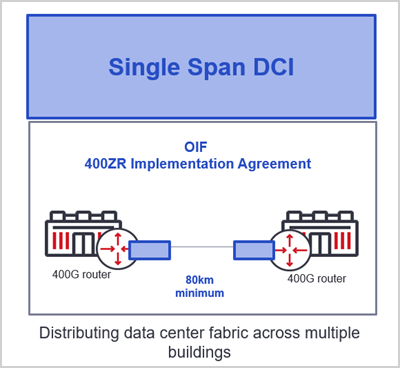What is 400ZR?
The last few years have seen significant growth in data center construction, a trend that’s set to continue. Global Content Network (GCN) companies are driving much of this data center build out—operating and evolving their networks to support cloud services on a massive scale.
As overall data center capacity scales to meet ever-growing demands for processing and storage, data center architectures are becoming increasingly distributed. Performance-critical applications such as business services, Artificial Intelligence (AI) and big data require low latency, high bandwidth East-West architectures to support the vast amount of machine-to-machine Input/Output (I/O) being generated between servers. To maintain application performance, the maximum fiber propagation between distributed data center locations must be limited to about 100 km.
Consequently, GCNs need to connect these data centers in distributed clusters, which need to have massive interconnect bandwidth and be in close proximity. These two key requirements are driving the need for a full-bandwidth optical interconnect solution that can deliver both high capacity and high density.
These requirements are met with 400ZR, an Ethernet-based networking interface defined by the Optical Internetworking Forum (OIF). Called an Implementation Agreement, or IA, 400ZR specifies 400 Gbps optical transmission over a single wavelength for Dense Wavelength Division Multiplexing (DWDM) deployments. The combination of 400 Gbps per wave and DWDM meets the first key GCN requirement of massive interconnect bandwidth.
Although the product form factor is not specified in the IA, as an industry body, the companies contributing to the 400ZR IA have also defined this specification with the aim of fitting the solution, both from a power and area perspective, into mechanical form factors such as the Quad Small Form Factor Pluggable Double Density (QSFP-DD) and Octal Small Form Factor Pluggable (OSFP). These form factors are separately defined by Multi-Source Agreement (MSA) bodies specifying compact mechanical modules that are connectorized and pluggable into a compatible socket in a system platform. With both the small physical size and low total power dissipation budget of a QSFP-DD, the second key GCN requirement for single-span DCI is met.
As the OIF and form factor MSAs are industry-wide organizations, the compatible 400ZR solutions that come to market will also be interoperable—which is a third goal of both the GCN end-user community as well as the broader industry. This is based partly on the legacy of many prior forms of lower-rate, pluggable, short-reach Ethernet transceivers. The solutions were not based on coherent optical technology but supported requirements similar to 400ZR, like high bandwidth and density for connecting within data centers as well as the need for ease-of-use for deployments of simple, point-to-point optical links. Likewise, interoperability of 400ZR solutions provides the dual benefits of easing both supply chain management and deployment. These parameters form part of the IA to support the development of interoperable solutions:
- Signaling rate (baud)
- Modulation format
- Total line capacity in Gbps (includes overhead for error correction)
- Specific Forward Error Correction (FEC) algorithms
- Host and line-side interface specifications, data framing and others
To realize 400ZR, new design techniques are employed for the coherent Digital Signal Processor (DSP) and the electro-optical devices to achieve the low power and small area needed to implement 400 Gbps coherent optical transmission in QSFP-DD and OSFP form factors.
In the coming years, a new part of the network will undergo transformation with 400ZR solutions meeting the specific space, power, and operational requirements of single-span DCI network connections.
Figure 1: 400ZR Application





